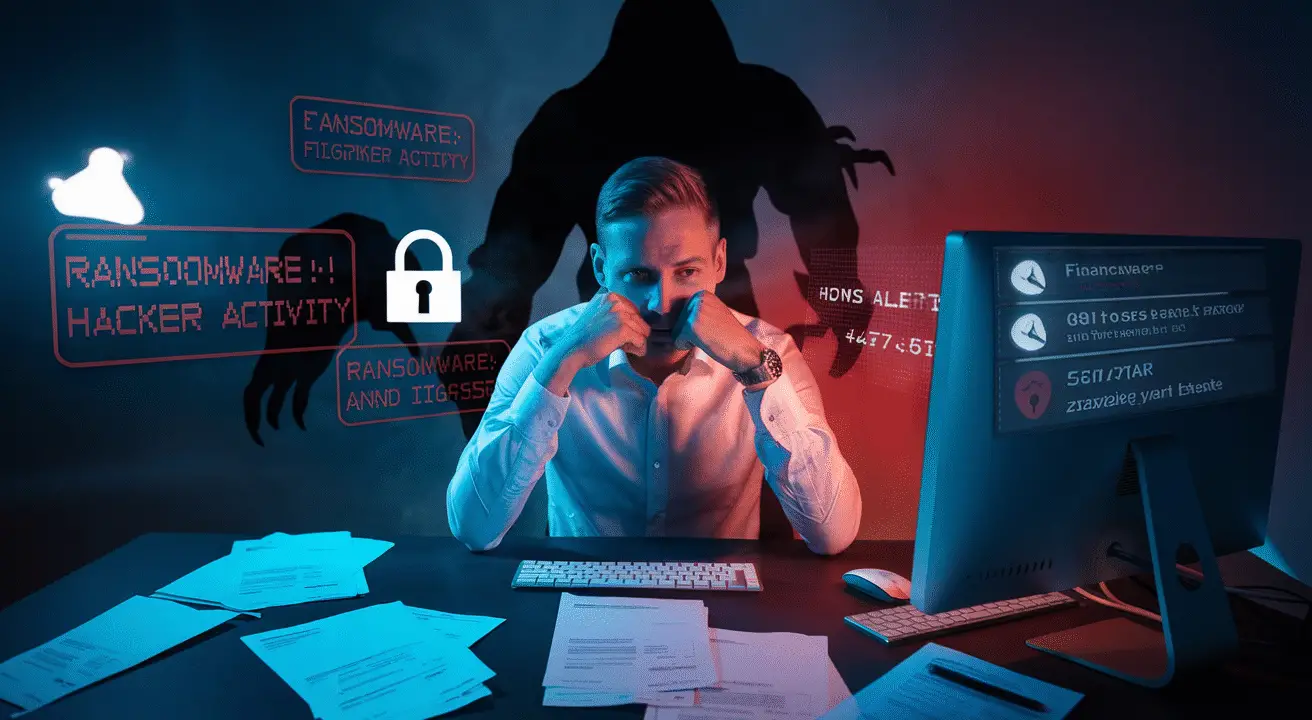
Ever looked at a business bankruptcy filing and wondered, “What the hell happened?” For 43% of small businesses last year, the answer was cybercrime. Not competition. Not the economy. Hackers.
Your coffee shop, law firm, or online boutique might seem too small to target, but that’s exactly what cybercriminals are counting on. Small business cybersecurity threats have evolved far beyond those sketchy “You’ve won!” emails your spam filter catches.
I’ve spent 15 years helping businesses recover from digital disasters, and I’m going to walk you through the five most devastating cybersecurity threats targeting small businesses right now. These aren’t theoretical risks—they’re active threats that could drain your bank account by this time tomorrow.
But here’s what keeps me up at night: the newest threat on this list? Most business owners don’t even know it exists.
Overview
The Invisible Threats Lurking in Your Business
Think your small business is too insignificant for hackers to bother with? Think again. While you’re focused on growing your customer base and managing cash flow, cybercriminals are eyeing your vulnerable systems as easy targets with potentially lucrative payoffs.
The statistics are downright terrifying. In 2025 alone, 68% of small businesses experienced a devastating cyberattack, with the average cost exceeding $120,000 per incident. For most small companies operating on thin margins, that’s not just a bad quarter—it’s potentially game-ending.
Why cybersecurity matters
Think your small business is too insignificant for hackers to bother with? Think again. 60% of small businesses that suffer a cyberattack fold within six months because they simply can’t absorb the financial blow.
Your company’s survival literally depends on taking cybersecurity seriously. Not just the technical stuff, but creating a culture where everyone from the CEO to the newest hire understands they’re the first line of defense against attacks that could erase everything you’ve built overnight.
Cybersecurity matters
The Real Cost of Ignoring Cybersecurity
Think your small business isn’t a target? Think again. In 2025, cybercriminals aren’t just going after the big fish anymore. They’re hunting the smaller ones because—let’s be honest—you’re probably easier to hack.
The numbers are scary. About 60% of small businesses that suffer a major cyber attack close their doors within six months. That’s not a typo. Six. Months.
Why? Because the average cost of a data breach for small businesses has skyrocketed to $149,000. And that’s just the immediate financial hit. We’re not even talking about the long-term damage to your reputation yet.
Beyond the Financial Fallout
When cybercriminals breach your systems, they don’t just steal money. They steal trust. Your customers trusted you with their data, and now it’s floating around on the dark web. Good luck rebuilding that relationship.
And those customers? They talk. A lot. One breach can trigger a social media nightmare that haunts your Google search results for years.
It’s Not Just About You
Your business doesn’t exist in a vacuum. You’re connected to suppliers, partners, clients—a whole ecosystem that depends on your security. When you get hacked, you become patient zero in a potential epidemic.
Remember that manufacturing company in Ohio last year? Their breach compromised 27 other businesses in their supply chain. Twenty-seven.
The Competitive Edge
Here’s a plot twist: strong cybersecurity can actually be a business advantage. In 2025, customers are choosing vendors partly based on how well they protect data. Having robust protection isn’t just defensive—it’s a marketing point.
You wouldn’t leave your store unlocked overnight. Don’t leave your digital assets unprotected either.
Best practices for preventing cyberattacks
Best practices for preventing cyberattacks
A. Train your employees
Your team is your first line of defense against cyber threats. Most attacks succeed because someone clicked a sketchy link or downloaded a fishy file. Regular training sessions aren’t optional anymore – they’re survival tools.
B. Secure your networks
Got Wi-Fi? Then you’ve got a potential entry point for hackers. Password-protect your networks, use a business-grade firewall, and separate guest access from your main network. Think of your network like your house – you wouldn’t leave the front door wide open, would you?
C. Use antivirus software and keep all software updated
Outdated software is like having a broken lock on your door. Hackers love finding these vulnerabilities. Install reputable antivirus solutions and enable automatic updates on everything – from your operating system to your accounting software.
D. Enable Multi-Factor Authentication
Passwords alone don’t cut it anymore. Multi-factor authentication adds another layer of security by requiring something you know (password) and something you have (like your phone). It’s like having both a lock and an alarm system.
E. Monitor and manage Cloud Service Provider (CSP) accounts
Your business data living in the cloud needs special attention. Review access permissions regularly, monitor account activities, and understand your cloud provider’s security responsibilities versus yours. Don’t assume they’re handling everything.
F. Secure, protect, and back up sensitive data
Data is your business’s lifeblood. Encrypt sensitive information, classify data based on importance, and maintain regular backups using the 3-2-1 rule: three copies, two different media types, one off-site. When (not if) disaster strikes, you’ll be ready.
Common threats
Common threats
A. Malware
Think your small business is immune to malware? Think again. These malicious software programs sneak onto your devices through sketchy email attachments, infected websites, or pirated software. Once inside, they wreak havoc – stealing sensitive data, corrupting files, and giving hackers backdoor access to your entire network.
B. Viruses
Viruses are the OG digital threat that just won’t die. They attach to legitimate files and spread like wildfire throughout your systems. The scary part? Many modern viruses can lurk undetected for months, silently corrupting your data and compromising your business operations before you even realize you’ve been hit.
C. Ransomware
Ransomware attacks are skyrocketing, and small businesses are prime targets. These attacks encrypt your critical business files and demand payment (usually in cryptocurrency) for the decryption key. Without proper backups, you’re faced with an impossible choice: pay thousands in ransom with no guarantee of recovery, or lose your data forever.
D. Spyware
Spyware flies under the radar, monitoring your every digital move. It tracks passwords, banking credentials, and confidential business information – all without your knowledge. The worst part? By the time you discover spyware, your sensitive data is already in someone else’s hands, potentially being sold on the dark web.
E. Phishing
Cybercriminals have mastered the art of deception through phishing. These attacks use fake emails, texts, or websites that look legitimate but are designed to steal credentials or install malware. Small businesses are particularly vulnerable because employees often lack security training to spot these increasingly sophisticated scams.
Assess your business risk
Assess your business risk
Ever wondered if you’re a sitting duck for cybercriminals? Don’t wait until your business accounts are drained to find out. Most small businesses that get hit never see it coming – but you can be different by taking stock of your vulnerabilities now.
A. Planning and assessment tools
Free tools like the FCC’s Small Biz Cyber Planner and NIST’s Cybersecurity Framework can be game-changers. These user-friendly resources help identify your weak spots without requiring a tech degree. Just answer some straightforward questions, and you’ll get a customized roadmap showing exactly where to focus your limited security budget.
Training and events
SBA Training
Thinking cybersecurity training costs a fortune? Think again. The Small Business Administration offers free workshops that could save your business from disaster. Their “Cybersecurity Essentials” program specifically addresses the unique vulnerabilities small businesses face in 2025, including the latest ransomware tactics targeting your industry.
Other Training
Don’t overlook industry-specific options that might already be included in your chamber of commerce membership. Organizations like SCORE also provide mentor-led cybersecurity sessions where you can bring real questions about your specific setup. The best part? Many offer virtual options you can access during lunch breaks.
Protect Your Business from Financial Devastation
Cybersecurity is no longer optional for small businesses. The five threats outlined in this post—ransomware, phishing attacks, insider threats, unsecured networks, and outdated software—have the potential to completely devastate your company’s finances and reputation. By implementing the recommended security practices, conducting regular risk assessments, and staying vigilant about emerging threats, you can significantly reduce your vulnerability to these attacks.
Don’t wait until after a breach to take cybersecurity seriously. Invest in proper employee training, update your systems regularly, and consider working with security professionals to establish robust protections. Your business’s survival may depend on the security measures you implement today. Take action now to protect everything you’ve worked so hard to build.














No Comments